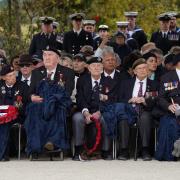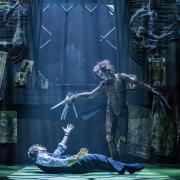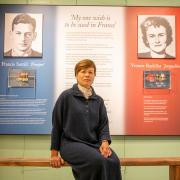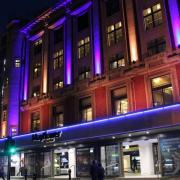No 60s and 70s childhood was complete without the stories of Billy Bunter and Malory Towers, brought to life by the Lymington artist Mary Gernat. Now her son Roger How wants to share her famous illustrations with those that remember them fondly says Sandra Cain

Oh lor’! …in a large, torn cardboard box on the floor in the corner of a picture framer’s workshop in Milford-on-Sea, Billy Bunter nestles alongside the girls from the fifth at Malory Towers. For those of us who grew up in Britain in the 1960s and 70s an immediate and striking vision of this most unlikely scenario will pop into our heads. Of course, I am not talking about the ‘real’ eponymous Bunter nor the boarding school ‘gels’ of Malory Towers but their carefully drawn and hand-painted images. Here in this cardboard box lay scores of old, brightly coloured paperbacks, the covers of which were all originally designed and painted by the Hampshire based illustrator and artist Mary Gernat.
I stumbled upon this treasure trove when I went to visit local picture framer, Roger How. As a lover of anything remotely ‘Blytonesque’, I was intrigued as to what this lot was doing on the floor…if there’s one thing that appeals to the jaded palette of us baby boomers it’s a peek back to the past - those happy, care free days of childhood adventures and the big outdoors.
“Mary Gernat was my mum,” said Roger. “She lived and worked in Lymington and illustrated over one hundred and twenty book covers for authors such as Enid Blyton, Monica Edwards, Richmal Crompton, Captain W. E. Johns, Frank Richards and the Pullein-Thompson sisters. My family is now the fortunate owners of the copyright of all the illustrations.”
Roger started to get the books out of the box, my mouth went dry and my palms began to sweat. I couldn’t wait to get my hands on them, such a veritable cache of social history.
I remark on the lively drawings of the characters, mostly children and animals, and the bright, intense colours of the illustrations. Roger chuckles, “A lot of those images of the boys were based on me and my brother, Francis. Even our dog, Patch, got in on the act. Mum would pay us in halfpennies and pennies to pose for her. ‘Roger,’ she’d say, ‘look like you’re casting a line to fish’, or, ‘Roger, look like you’re washing the dog in the bath’. It was a great way to earn a bit of pocket money. Mum would do a quick three or four minute sketch and then turn it into something rather magical. She even got my dad, Michael, to pose for the character of the Blue Pirate in the Dragon Pirate stories by Sheila McCullagh. Those books were school learning aids so dad managed to get his ‘pirated’ image into nearly every primary school in the 1960s. After mum died, I found a large piece of paper with doodles of dad sword fighting drawn on it.”
Mary Gernat was obviously prolific.
“Her life changed when she got a contract with Armada Paperbacks back in the 1960s. Those books sold in all the commonwealth countries, South Africa, Australia, Canada, New Zealand, so a lot of people have seen her illustrations, although unfortunately, Armada never cracked the American market.”
Roger obviously has very special memories of his mother and I am keen to know more about her life and work. “Mum was passionate about painting,” he explains. “She painted every day, mostly local scenes of Lymington and beyond.”
Indeed, as I look around, I can see that the walls of Roger’s framing studio are peppered with prints of his mother’s lively and energetic watercolours.

“She trained at the Central School of Arts and Crafts in Kingsway, London and then at the Regent Street Polytechnic. She worked for Tatler and the Sunday Times as well as Armada Paperbacks. Mum and dad moved to Milford on Sea in 1962 and then on to Lymington in 1970. She was quite a humble and private person but she did enjoy painting from life and would gather quite a crowd around her when she painted in the streets. She’d sit in her wheelchair, pop her easel on her knees and just paint. She’d often just sell her paintings cheaply there and then to passers by who asked for them. She loved to paint streets, buildings and the Lymington market. She also liked to paint children’s portraiture and I have loads of her original pastels of little girls dancing ballet in the local community centre.”
I remark that those little girls will be grown women now and would probably dearly love to see those original drawings.
“When Mum developed multiple sclerosis, it didn’t stop her painting. She became a member of the Society for Disabled Artists (SODA) at New Milton and the Palette Club in Lymington. She also signed cards to be sold in aid of the Lymington and District Branch of the Multiple Sclerosis Society. Sadly she died in 1997.”
I remark on the wonderful legacy that Mary Gernat left to her son and ask Roger what he plans to do with all that original, iconic artwork from Armada Paperbacks.
“I really don’t want mum’s work to be forgotten, it smacks of nostalgia and speaks to us of golden times when it was safe to play outside, to invent games, to get our clothes grubby, have adventures and drink lashings of ginger beer. Those characters are instantly recognisable, their vibrancy is compelling but most of all they are great fun. I now have a website of some of mum’s work where people can purchase high glycee prints. But I really want to exhibit some of the more famous original illustrations. A revival of mum’s work would be great.”
Commercially however, there seems to be a window of opportunity with the 70s back in fashion.
“I’d like to licence some of the images for homeware. They are a brand in their own right. It would be great fun for kids to snuggle down in bed with a Bunter themed duvet cover or a Just William themed pillowcase, or wear a Malory Towers themed bathrobe. The opportunities are endless - but we’ll see,” says Roger. “My head is spinning with exciting possibilities, but the most important thing for me is just to keep interest alive. The original illustrations for the book covers have never been exhibited in public before and I think there would be real interest in them as a piece of social history. They tell us a bit about the British national character back in the 60s and 70s and the nature of family life. They are images of happiness, adventure and exploration. These things are important. My next task is to garner interest in an exhibition, St. Barbe Museum in Lymington would be great.”
If you would like to see some of the book covers illustrated by Mary Gernat, you can find the books in the box on the floor in the corner at Picture Perfect, Barnes Farm Business Park, Milford on Sea, or at www.theartofenidblyton.com. We hope they will quickly find a more prominent home for all to enjoy soon.
READ ON
• 10 castles and forts to visit in Hampshire - The castles and forts around the county make for a fascinating ghost hunt by night, and a fun family trip by day says Claire Pitcher
• Mike Batt and his contribution to the cultural landscape of Britain - The Southampton boy who became the star of Wimbledon with his Wombles theme tune: Mike Batt has contributed more to the cultural landscape of Britain than many people realise with his flair for classical composition says Karen Anne Overton



























